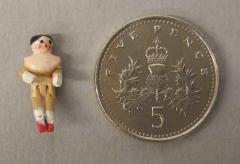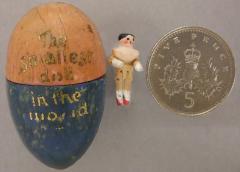ENGLAND: THE OTHER WITHIN
Analysing the English Collections at the Pitt Rivers Museum
"The smallest doll in the world"
Mariana Pote
St Catherine's College

1944.7.61 The doll set beside an English 5p coin for scale. Photographs taken with microscope camera by Conservation Department
It comes with an egg which opens in two parts, one part painted with in pink pigment, the other in blue. The legend painted in gold upon the egg boldly states, “The smallest doll in the world”. When closed the egg is about 3.2cm in height and 1.3cm at its widest. The doll itself measures about 1.3cm in height. The arms and legs are jointed and moveable. This kind of doll is known as a peg-wooden doll, referring to the jointing technique where by the arms and legs are attached to the body with pegs. The doll's arms and legs are locked together by a jointing system, so that when one arm is moved the other moves too.
The face and chest is painted skin colour pink with a black dot for each eye, a red dot for the nose and a darker pink for the cheeks. Its hair is represented with black paint. The lower part of the arms and legs are painted in white, with red on the feet. That the upper part of her legs and arms and central part of her body are not painted, suggests that this doll was supposed to be dressed once purchased.
Despite its peculiarity, the bizarreness of a doll in an egg is not as unique as one might imagine. A book on dolls described a similar doll, which had the word “Easter” burned diagonally on the egg. The author suggests dolls like this were “An Easter present to a child in England during the early years of the 20th century” (Merrill 1985: 377ff). Easter eggs were commonly gifted to children, suggesting this was quite possibly the fate of this doll. Records of similar dolls can currently be found on sale on the internet and sellers suggest that dolls like this were produced in Germany and Austria in 1900s and 1930s for the English market. Along with other similar dolls, it is referred to as a ‘penny doll’, the price for which it would be bought in England.
On Miniaturisation and Dolls
The size and the fact that the doll ‘nests’ within an egg suggests it should be displayed within it and that it is not an object to be played with but rather to be looked at and admired. That these were a popular purchase item during Easter further implies that these were commemorative rather than play objects. Indeed Newall (1965) suggests that the best Pace eggs were saved and used as ornaments in homes. One could draw a parallel with George Herbert’s notion of man as a little world, a perfectly proportioned universe, the doll celebrating that perfection. The parallel is seen further in the term microcosm, which from 1400 -1650 was used in English as a synonym for man (Stewart 1993: 129ff, Lotze 1885).
Susan Stewart (1993) in her analysis of narratives and objects refers to miniatures as being the ultimate demonstration of craftsmanship of the maker. In this sense the miniature could be said to act as the exemplary object of cultural supremacy. In the 19th century books were made miniature as an experiment in minuteness and skill, “it is the hand that has produced these volumes and the hand that has consumed them – they are an affront to reason and its principle sense – the eye” (Stewart 1993: 40ff). Indeed the level of precision and technicality that has gone into making it dazzles the viewer. We are fascinated not so much by the object itself but with the dexterity of the maker to manipulate and inscribe such detail (Gell 1998). The smallness of the doll is the essence of its uniqueness and superiority versus other dolls.
Ultimately, the miniature illustrates a Victorian obsession with detail. Miniaturisation in Europe occurs particularly with objects related to domesticity, the home, women and children. This reveals the miniature as a cultural product. Stewart refers to toys as models projected by adult invention and as fundamentally nostalgic objects. John Mack (2007) has further discussed the relationship between small bodies and the adult world, suggesting that these kinds of objects explore the relationship and differences between the two, children being idealised in miniature forms. Tom Thumb is a good example of this, as the small little son of two normal sized parents who renders their reality magical and imaginary. The reduction in scale of objects associated with the home provides them with charm, “That the world of things can open itself to reveal a secret life (…) is a constant daydream that the miniature presents” (Stewart 1993: 54ff).
On Containment
Stewart further suggests that reducing the size of objects creates a world of its own. A world of reduced scale provokes the imaginary. Describing the dollhouse of Victorian nurseries as the ultimate example of this Stewart suggests we may see the dollhouse as a container of a set of small people, rooms and furniture which are familiar in our everyday life. In the dollhouse they are materialized in small and immobile form but we fantasize that the lives contained within the dollhouse come to life when we turn our back. In this sense the dollhouse reveals a layering process, as a house within a house. This containment that ‘shrinking’ provides is important to highlight in relation to the doll and the egg. That the doll comes with a two part egg, one half blue and one pink is highly symbolic of gender notions. The doll is made to be both inside and outside, enclosed and exposed.
All over the world, wherever eggs are laid, they represent life and fertility and are symbolic of creation and resurrection” (Newall 1984: 21ff).
Easter eggs are highly symbolic and are known as traditions particularly throughout Eastern Europe, Germany and England. As well as being gifted to children, as decorated (often painted) eggs and today more commonly as chocolate eggs, in the past, Easter eggs were also used as love gifs. Although eggs were not always associated with Christian traditions their evocative containment of a life in making provided for a possible association with Easter and the celebration of Christ’s death and subsequent resurrection (see Newall 1984).
This tiny egg is associated with ideas of origin, birth and life which are revealed by its contents. Figuratively, the closed egg could be said to materialize a secret and the doll to be its revelation (see Stewart 1993).
On the Collector
The doll was owned by Gwladys Marguerite Alchin and donated to the museum in July 1944, when Ms. Alchin was 66 years old. Along with her twin brother Basil, the Alchin’s were born in Oxford in 1878. Later records suggest Ms. Alchin was employed as a typewriter and shorthand clerk and lived in Clapham, London. Gwladys was unmarried and the owner of her old family home at 47 Broad Street, Oxford from 1927 until its demolition in 1929. With a long old age she died in 1972 aged 94 years.
For similar examples of tiny wooden dolls see:
Merrill, M. O. (1985) The Art of Dolls 1700-1940, Robert Hale: London
http://www.lostnfoundantiques.com/items/734689/item734689store.html
http://www.antiquedolls.co.nz/tiny_peg_wooden_in_egg.html
Further Reading
Daiken, L. (1953) Children’s Toys Throughout the Ages, B.T. Batsford Ltd.:London
Gell, A. (1998) Art and Agency, Oxford University Press: Oxford
Lotze, H. (1885) An Essay Concerning Man and his Relation to the World, vol. 1, Edinburgh
Mack, J. (2007) ‘Small Bodies’ in his The Art of Small Things, The British Museum Press: London
Newall, V. (1984) 'Easter Eggs: Symbols of Life and Renewal', Folklore 95(1): 21-29
Newall, V. (1965) 'Decorated Eggs', Folklore 76(4): 266-272
Stewart, S. (1999) On Longing: Narratives of the Miniature, the Gigantic, the Souvenir, the Collection, Duke University Press: London
http://www.alchin.info/volume5/volume5_part6_004_descendants_francis_catherine_alchin_london.html
